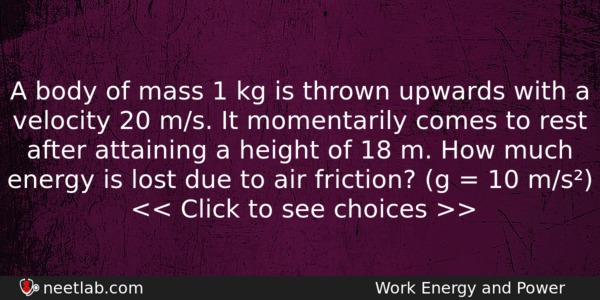| ⇦ | 
| ⇨ |
A body of mass 1 kg is thrown upwards with a velocity 20 m/s. It momentarily comes to rest after attaining a height of 18 m. How much energy is lost due to air friction? (g = 10 m/s²)
Options
(a) 30 J
(b) 40 J
(c) 10 J
(d) 20 J
Correct Answer:
20 J
Explanation:
When the body is thrown upwards. its K.E is converted into P.E. The loss of energy due to air friction is the difference of K.E and P.E
1/2 mv² – mgh = 1/2 x 1 x 400 – 1 x 18 x 10
= 200 – 180 = 20 J
Related Questions: - A particle of mass ‘m’ is kept at rest at a height 3R from the surface of earth
- If rope of lift breaks suddenly, the tension exerted by the surface of the lift
- Weight of a body of mass m decreases by 1% when it is raised to height h
- Two circuits have a mutual inductance of 0.1 H. What average e.m.f. is induced
- Two capacitors of 10pF and 20pF are connected to 200V and 100V sources, respectively.
Topics: Work Energy and Power
(94)
Subject: Physics
(2479)
Important MCQs Based on Medical Entrance Examinations To Improve Your NEET Score
- A particle of mass ‘m’ is kept at rest at a height 3R from the surface of earth
- If rope of lift breaks suddenly, the tension exerted by the surface of the lift
- Weight of a body of mass m decreases by 1% when it is raised to height h
- Two circuits have a mutual inductance of 0.1 H. What average e.m.f. is induced
- Two capacitors of 10pF and 20pF are connected to 200V and 100V sources, respectively.
Topics: Work Energy and Power (94)
Subject: Physics (2479)
Important MCQs Based on Medical Entrance Examinations To Improve Your NEET Score
18000+ students are using NEETLab to improve their score. What about you?
Solve Previous Year MCQs, Mock Tests, Topicwise Practice Tests, Identify Weak Topics, Formula Flash cards and much more is available in NEETLab Android App to improve your NEET score.
Share this page with your friends

Leave a Reply